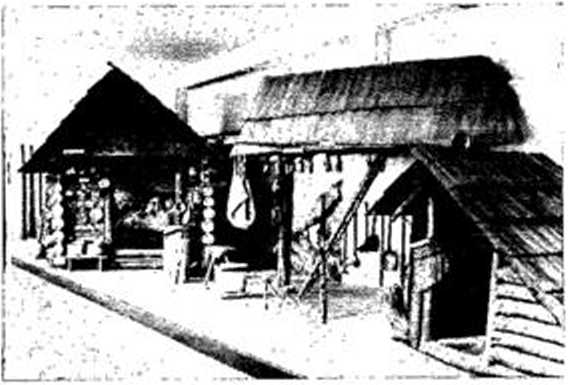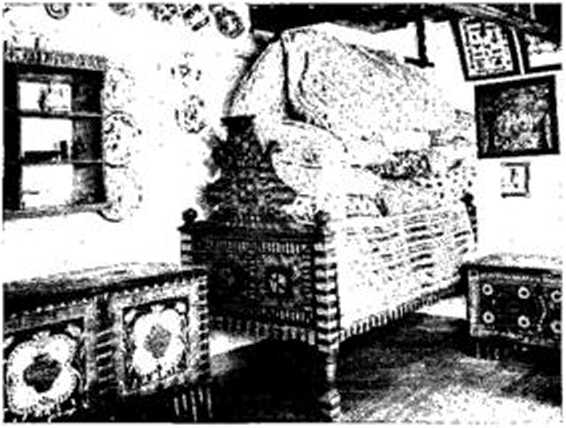3416400715

26. Slovenske Narodni Museum, Martin. La construction des chalets s!ovaqucs.-
26. Slovak chalet construction.
la constitution de fiches systematiques pour chaque objet. Lcs fichiers sont etablis avec, la plupart du temps, la description phototechnique des objets selon un nombre dc criteres variabie d’un musee 4 1’autre.
A cótć de la documentation, la bibliothćque ethnographique du musee est orga-nisee selon les memes principes et comprend au moins deux catalogues, l’un par auteurs, 1’autre par matteres. Cest aujourd’hui au dćpartemcnt ethnographique du Musće dc la Moravie a Brno, qui a depouillć une partie considerable de la littćrature consacrće a 1’ethnographie et au folklore tcheques, que se trouve pratiquement le centrc d’etude bibliographique de ces scicnces pour la Boheme et la Moravie.
En ce qui concerne 1’entretien et la protcction des collcctions, les travailleurs des musćes ethnographiques recherchent et experimcntent de nouvelles methodes dc restauration, ćventuellement de reconstitution, applicables aux objets formćs de matieres perissables et d’origine organique, et ils ćtudient des procedes nouveaux qui garderaient a ces objets cctte fraicheur de coloris qui represente souvent la notę dominantę de Bart populaire.
( Traduit du tcheqm.)
Ethnographical Museums
by Lud vi k Kunz

27. Slovenske Na rodni Museum, Martin. Reconstitution d’un intćricur de Ćataj, Musće national dc la Slovaquie.
27. Reconstruction of a Ćataj interior, Slovak National Museum.

The collcctions of the ethnographical museums in Czechoslovakia provide a concrete picture of the traditional and contemporary culture of the country. In their task of illustrating the materiał culture and the civilization of the t\vo peoples of Czechoslovakia from bygone days to modern times, they constitute their collections of characteristic and artistically significant products of human activity in accordance with special critcria serving the advancement of science and aiming at the conservation of the cultural heritage of the nation.
These striking vestiges of a cultural past, expressivc of the seed from which the nation sprang, and these significant products of the popular arts of today which link up with and develop the old tradition, are not merely the object of scientific research but play an important part in educational work and the development of cultural activities.
Anothcr fcature of these collcctions is that they not only consist of an extra-ordinarily largenumber of folk art objects, testifying to the creative gifts of the people, but that large groups of objects have been built up to illustrate the nation’s materiał culture and aspects of its social life. In building up their collections, the museum stalfs concentrated from the outset on the traditional and truły popular materiał produced by almost all sections of the workers, and not only on the work of the various groups engaged in craft or other occupations connected with rural life and occupations; the majority of them did not simply confine themselves to collecting materiał relating to the ethnography and folk art of the predominant peasant element; thanks to their efforts, the collections of the Czechoslovak museums are highly representative of the materiał produced by rural craftsmen and of the seasonal and occasional materiał produced by working people in the towns, by miners and industrial workers, and in a large number of characteristic cases, by members of the poorest groups of the population who had had to leavc the country to seek work abroad. This diversity in the ethnographical collections and their wide rangę of social origin is their hallmark and greatly cnhances their value from the scientific point of view.
This collection-building effort, conducted for over half a century in rcspect of the traditional folk art of the various social groups, and this long-standing scientific cndcavour to obtain a complete picture of the development of popular culture, can be seen in retrospect to have been a successful and methodologically sound approach to museographical collection work. At the same time, it represents a substantial point of vantage from which to obtain a complete museographical picture of the development of popular culture over the past two centuries.
The work of building up collections has been going on intensively and uninter-ruptedly sińce about 1890, with the result that Czechoslovak museums now have
Wyszukiwarka
Podobne podstrony:
114 pour la construction des navires a double coque capables de naviguer dans les eaux arctiąues, et
1*. < -
58 et de dispersion des polluants a ete mis au point, la construction du Systeme d information
— 26 — A Dans la plupart des lieux consacrćs 5 la Yierge Marie, il existe de vieilles foires. Confor
EXAMEN La construction de maracas avec la section des grands en ecole maternelleEntretien avec le ju
44 MEMNONIA I a 1’angle nord-ouest des vestiges de la construction initiale, due h Sćthi Ier, laquel
.1 12. NArodnI Museum v Prazc. I.a Semaine des musłts celćbrće solcnncliemcnt cn 1956 a ćre rcn
29. Sloyenske NA-ROdnI Museum, Martin. Costumes de la region dc Tmava, Musćc national de la
30 La recherche de Martin s’inscrit aussi dans la perspective des travaux de Franęoise Noel et Jean-
Fleurs en perles? rocaille,V redimensionner ROSĘRoso La rosę est considerec commc la rcine des Jleur
& : - W 7 - Vu la diuersitć de la composition en essences, de la structure de la florę, des situ
b * 3 f i I U632 Methodes de construction des matrices de transition Nous decriuons ici deux mćthode
la proportlon des arbres de la categorie i qui sont exploites., tout ceoi pendant l interualle m, r
7 l ; 1 I * * y 0 ? 7 CONTROLE DE LA VALIDITE DES MODELES D*ACCROISSEMENT ET DE
- 139 - 73 LES ECARTS RESIDUELS Le contrdle de la validitó des modeles s’appuie gónćralement sur l a
cettes d un óchantillannage classiąue. Si la taille des placettes est la m§me pour les deux types dr
= = - 158 - <v« AJUSTEMENT D UNE EQUATION PAR LA METHODE DES MOINDRES CARRES . ^ A21 REGRESSION U
więcej podobnych podstron